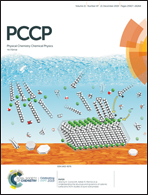Hydrogen attachment dissociation of peptides containing disulfide bonds†
Abstract
A combination of tandem mass spectrometry (MS/MS) and hydrogen attachment dissociation (HAD) is a useful method for peptide sequence analysis. In this study, gas-phase fragmentation induced by the attachment of hydrogen to peptides containing disulfide bonds was investigated. Hydrogen attachment induced the cleavage of either the disulfide or N–Cα bond, which competitively occurred during HAD. The disulfide bond cleavage proceeded through an intermediate, which contains a thiyl radical (–S˙) and a thiol group (–SH). In contrast, N–Cα bond cleavage produced an intermediate containing an enol-imine group and α-carbon radical. The intermediate α-carbon radical then attacked the disulfide bond, resulting in a cyclic [z]+ fragment. The counterpart, [c + H]+˙ with a thiyl radical underwent further hydrogen attachment, producing [c + 2H]+. Because both disulfide and N–Cα bonds were cleaved by a single hydrogen attachment event, HAD-MS/MS can provide sequence information for the backbone region in the disulfide loop.



 Please wait while we load your content...
Please wait while we load your content...